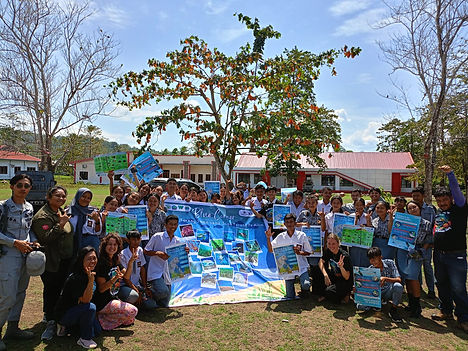North Sulawesi Marine Protected Areas
Status: Ongoing, since 2016
North Sulawesi Province is located in the north-central part of Indonesia near the heart of the coral triangle region, beside the Sulu-Sulawesi Sea Eco-Region. It has a very high marine biodiversity, that acts as the foundations of very lucrative fishing and marine tourism industries. These regions are endowed with high abundance of natural resources and are part of the world’s highest marine biodiversity region where more than 70 genres of hard corals and 2,500 species of fish occur. Several places in Minahasa are hotspots for marine turtle nesting, dugongs, the Indonesian Coelacanth or King of the Sea (Latimeria menadoensis) and several species of cetaceans, while in terrestrial sites one can find the Crested Black Macaque (Macaca nigra) and tarsiers (Tarsius spectrum). Unfortunately the region is also home to many vulnerable and endangered marine species that need improved protection through the designation of Marine Protected Areas (MPAs).
However, that is not easy, because the majority of people living in coastal villages are strongly dependent on marine resources. Even inland, because of the population growth and socio-economic development, there is an increasing demand for fish and aquaculture products. This rise in demand has led to an increased pressures on marine ecosystems, and has accelerated degradation and exploitation of the ecosystems.

Map (1)

Map (2)
Manengkel Solidaritas works alongside coastal communities in North Sulawesi to protect marine ecosystems through community-based Marine Protected Areas (MPAs). From Bitung to Kapitu and Tarabitan, the program safeguards coral reefs, mangroves, and small-scale fisheries while also supporting the livelihoods of local fishers.
Key activities include ecological and socio-economic surveys to establish zoning, village consultations to agree on local regulations, regular patrols by community surveillance groups (Pokmaswas), ecosystem restoration through coral transplantation and mangrove rehabilitation, as well as environmental education for schools and women’s groups. Manengkel has also introduced sustainable financing mechanisms, such as eco-tourism contributions and establishment of Women Cooperatives at villages that support the Marine Protected Area from their businesses.
So far, the program has achieved major milestones: the official designation of the Bitung Marine Protected Area (2024), training of more than 50 community members in patrols and monitoring, the successful transplantation of hundreds of corals, and significantly increased community awareness about marine conservation. These achievements mark an important step toward fish stock recovery, healthy ecosystems, and sustainable coastal livelihoods.

Map 3: The Marine Protected Area of Bitung City-Lembeh island


MPA awareness campaign in local schools

Marine Protected Area Zones – Community Information
This project is supported by :




_JPG.jpg)
_JPG.jpg)



